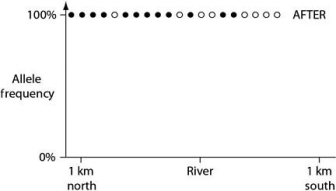Please use the following information to answer the question(s) below.
In the ocean, on either side of the Isthmus of Panama, are 30 species of snapping shrimp; some are shallow-water species, and others are adapted to deep water. There are 15 species on the Pacific side and 15 different species on the Atlantic side. The Isthmus of Panama started rising about 10 million years ago.
In Figure 22.1, the isthmus separates the Pacific Ocean on the left (side A) from the Atlantic Ocean on the right (side B) . The seawater on either side of the isthmus is separated into five depth habitats (1-5) , with 1 being the shallowest.  Figure 22.1
Figure 22.1
-In a hypothetical situation, the National Park Service, which administers Grand Canyon National Park in Arizona, builds a footbridge over the Colorado River at the bottom of the canyon. The footbridge permits migration to occur between populations of two closely related antelope squirrels. Previously, one type of squirrel had been restricted to the terrain south of the river, and the other type had been restricted to terrain on the north side of the river. Immediately before and 10 years after the bridge's completion, researchers collected 10 antelope squirrels from both sides of the river, took blood samples, and collected frequencies of alleles unique to the two types of antelope squirrels (see the graphs in Figures 22.2 and 22.3) .  Figure 22.2
Figure 22.2 
Figure 22.3
The data in these graphs indicate that
Definitions:
Budget Shortage
A financial situation in which an entity’s expenditures exceed its revenues over a particular period of time, leading to a deficit that must be addressed by borrowing, spending cuts, or tax increases.
Market Wage
The prevailing rate of pay for work or labor, determined by the supply and demand for labor in the job market.
Transitive Preferences
In decision-making, the condition where if an individual prefers option A to option B and option B to option C, then they also prefer option A to option C.
Majority Rule
A decision-making rule in which the preferences of more than half of the members in a group have authority over decisions.
Q3: Taxonomically, what should be done with the
Q10: In the formula for determining a population's
Q13: What is metagenomics?<br>A) genomics as applied to
Q18: Which of the following problems with animal
Q18: Charles Darwin was the first person to
Q25: The primary treatment for giardiasis (infection with
Q38: What is true of natural selection?<br>A) Natural
Q49: Figure 19.1 shows an outcrop of sedimentary
Q115: A covalent chemical bond is one in
Q128: How many neutrons are present in the